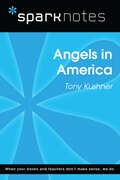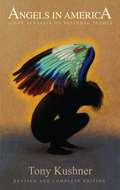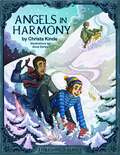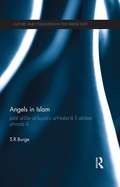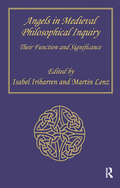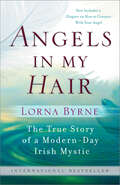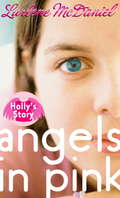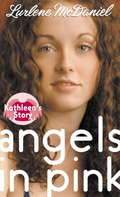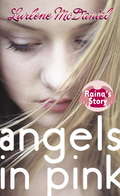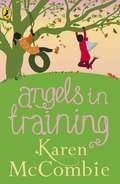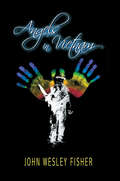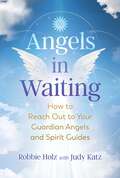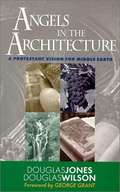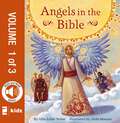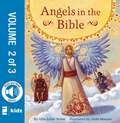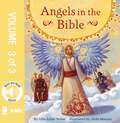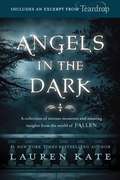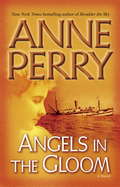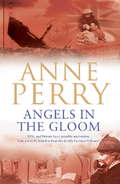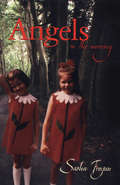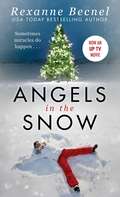- Table View
- List View
Angels for Christmas
by Tamela Hancock Murray Gail Sattler Pamela Griffin Sandra PetitBArbour republishes for favorite Christmas short novels in this anthology for 2005: Strawberry Angel by Pamela Griffin: Noelle accidentally dyes her hair a shocking strawberry pink, which is the catalyst that brings two adorable homeless children and their sick mother into her life. It also reunites her with Todd, her high school crush. With Christmas coming, Todd helps Noelle build a set and direct rehearsals for a play at the women's shelter where she volunteers. Can this strawberry Christmas" be one to remember? Angel Charm by Tamela Hancock Murray: Charm school owner Lydia Winters is known as one of the most engaging woman at her church. Yet despite her prayers, the Lord hasnt seen fit to send her a godly husband. But when her high school sweetheart Drake Kingston, now a widower with a rebellious daughter in tow, returns to town, can the flame reignite with the help of a child's crafted angel? Or will Lydia once again discover she shouldn't play with fire? Angel on the Doorstep by Sandra Petit: Finding a stray crocheted angel gives Moira Sullivan the idea to make some angels of her own, which she delivers anonymously to every person on the hard working staff at First Christian Church. When Joe Corrigan discovers Moira is the secret gift giver, he coerces her into letting him help with the project. Will this forced togetherness bring them closer together or farther apart? An Angel for Everyone by Gail Sattler: Kim is pleased with the beaded angel ornaments she's made as party favors for the church's annual Christmas party until Trent points out that there won't be 30 people attending, but 300. When the shock wears off and Trent offers to help make more, Kim doesn't know whether to be happy or terrified. She's tried to get Trent's attention for years, but He's never taken her seriously. Will his participation now make things better or worse?
Angels in America (SparkNotes Literature Guide Series)
by SparkNotesAngels in America (SparkNotes Literature Guide) by Tony Kushner Making the reading experience fun! Created by Harvard students for students everywhere, SparkNotes is a new breed of study guide: smarter, better, faster.Geared to what today's students need to know, SparkNotes provides:*chapter-by-chapter analysis *explanations of key themes, motifs, and symbols *a review quiz and essay topics Lively and accessible, these guides are perfect for late-night studying and writing papers.
Angels in America: A Gay Fantasia on National Themes
by Tony Kushner<p>Winner of the Pulitzer Prize for Drama <p>Angels in America: A Gay Fantasia on National Themes includes Part One, Millennium Approaches and Part Two, Perestroika <p>This new edition of Tony Kushner's masterpiece is published with the author's recent changes and a new introduction in celebration of the twentieth anniversary of its original production. One of the most honored American plays in history, Angels in America was awarded two Tony Awards for Best Play and the Pulitzer Prize for Drama. It was made into an Emmy Award-winning HBO film directed by Mike Nichols. This two-part epic, subtitled "A Gay Fantasia on National Themes," has received hundreds of performances worldwide in more than twenty-six languages.</p>
Angels in Harmony (Threshold Series)
by Christa J. KindeAn illustrated companion to the Threshold Series by Christa Kinde. Angels have always served in pairs, but Baird is sure there must be some mistake when Kester shows up on his doorstep. The vividly energetic redhead couldn’t have been more different from his genteel new apprentice. Yet their rocky beginnings give way to a unique balance, proving that friendship can flourish in the unlikeliest of places, given time, trust, and the Twelve Days of Christmas. Includes a bonus first chapter from Book #3 in the Threshold series, The Broken Window!
Angels in Islam: Jalal al-Din al-Suyuti's al-Haba'ik fi akhbar al-mala'ik (Culture and Civilization in the Middle East)
by Stephen BurgeAngels are a basic tenet of belief in Islam, appearing in various types and genres of text, from eschatology to law and theology to devotional material. This book presents the first comprehensive study of angels in Islam, through an analysis of a collection of traditions (hadīth) compiled by the 15th century polymath Jalāl al-Dīn al-Suyūtī (d. 911/1505). With a focus on the principal angels in Islam, the author provides an analysis and critical translation of hadith included in al-Suyuti’s al-Haba’ik fi akhbar al-mala’ik (‘The Arrangement of the Traditions about Angels’) – many of which are translated into English for the first time. The book discusses the issues that the hadīth raise, exploring why angels are named in particular ways; how angels are described and portrayed in the hadīth; the ways in which angels interact with humans; and the theological controversies which feature angels. From this it is possible to place al-Suyūtī’s collection in its religious and historical milieu, building on the study of angels in Judaism and Christianity to explore aspects of comparative religious beliefs about angels as well as relating Muslim beliefs about angels to wider debates in Islamic Studies. Broadening the study of Islamic angelology and providing a significant amount of newly translated primary source material, this book will be of great interest to scholars of Islam, divinity, and comparative religion.
Angels in Medieval Philosophical Inquiry: Their Function and Significance (Ashgate Studies In Medieval Philosophy Ser.)
by Martin LenzThe nature and properties of angels occupied a prominent place in medieval philosophical inquiry. Creatures of two worlds, angels provided ideal ground for exploring the nature of God and his creation, being perceived as 'models' according to which a whole range of questions were defined, from cosmological order, movement and place, to individuation, cognition, volition, and modes of language. This collection of essays is a significant scholarly contribution to angelology, centred on the function and significance of angels in medieval speculation and its history. The unifying theme is that of the role of angels in philosophical inquiry, where each contribution represents a case study in which the angelic model is seen to motivate developments in specific areas and periods of medieval philosophical thought.
Angels in My Hair: The True Story of a Modern-Day Irish Mystic
by Lorna ByrneFor anyone who has ever wondered about the mysteries that lie beyond everyday experience, or doubted the reality of the afterlife, Angels in My Hair is a moving and deeply inspirational journey into the unseen world.For as long as she can remember, Lorna Byrne has seen angels. As a young child, she assumed everyone could see the otherworldly beings who always accompanied her. Yet in the eyes of adults, her abnormal behavior was a symptom of mental deficiency. Today, sick and troubled people from around the world are drawn to her for comfort and healing, and even theologians of different faiths seek her guidance. Lorna is trusted for her ability to communicate with spirits and angels--and by sharing her intimate knowledge of the spiritual world she offers a message of hope and love to us all. Angels in My Hair is an engrossing chronicle of Lorna's incredible life story. Invoking a wonderful sense of place, she describes growing up poor in Ireland, finding work in Dublin, and marrying the man of her dreams--only to have the marriage cut short by tragedy. Already a bestseller in Ireland, her story gives readers a unique insight into the angelic help that is around us and available to us all the time. As Lorna says, "All you have to do is ask."In this uplifting autobiography, a modern-day Irish mystic shares her vivid encounters and conversations with the angels and spirits she has known her entire life.
Angels in Our Room: A Journey through the Heartache of Infertility to the Joy of Divine Purpose
by GL MendenhallAngels in Our Room is a story of one couple&’s journey through infertility and an angelic encounter that gives hope to us all. The Bible tells us that God will give us the desires of our hearts, but for couples walking through the long, lonely road of infertility, that promise can feel empty. GL and Jason Mendenhall have been there. For nearly ten years, they took test after pregnancy test, praying desperately for those positive pink lines. But their story has a twist you would never expect. As the title Angels in Our Room suggests, Jason and GL had an incredible experience with actual angels in their bedroom. And what the angels revealed to them has significant implications for every single one of us. In this moving testimony, GL shares the details of their ten-year struggle with infertility, the incredible night during which they were visited by three angelic messengers, and the message they had for the Mendenhalls and all of us. When you finish this book, you&’ll feel alive with hope and full of worship for our one, true Creator God.
Angels in Pink: Holly's Story
by Lurlene McdanielPink Angels and best friends Holly, Raina, and Kathleen have been through a lot over the past year. The summer before their senior year promises to be busy but fun, as Holly and Raina return to their full-time volunteer jobs at the hospital and Kathleen, who needs the money, works at the hospital gift shop. Of course, Raina and Kathleen will be spending as much time as possible with their boyfriends, Hunter and Carson. Holly is happy for her friends, but she can't help feeling a little left out when hanging out with the two couples. She does finally have a boy interested in her, but the e-mails from her secret admirer, Shy Boy, have recently stopped coming. What has she done wrong? Will she ever meet her mystery guy in person? But Holly's world is forever changed when tragedy strikes close to home. It's not fair that the most loving and giving person she knows is the victim of a random crime. She, Raina, and Kathleen will need each other now more than ever.
Angels in Pink: Kathleen's Story
by Lurlene McdanielIt's the summer after sophomore year and Raina has convinced her best friends since the sixth grade, Kathleen and Holly, to spend their summer as "pink angels" in Parker-Sloan General Hospital's summer volunteer program. Kathleen is reluctant to do it--she has enough responsibility at home caring for her sick mother. But when she meets Carson, a cute and flirty fellow volunteer, she is happy that she joined the program. Or, at least, she thinks she is. Carson's "old friend" Stephanie keeps showing up at all the wrong times. And Kathleen's mother keeps complaining that she needs Kathleen at home. But with friends Raina and Holly by her side and her Pink Angel t-shirt on her back, Kathleen is able to realize that helping others also allows you to help yourself.From the Hardcover edition.
Angels in Pink: Raina's Story
by Lurlene McdanielRaina is happy and relieved that her friends Kathleen and Holly found volunteering at the hospital rewarding. They loved their summers at the hospital so much they will be working for credit during their junior year. Raina is also looking forward to spending as much time as possible with Hunter during their last year of high school together. Kathleen is still dating Carson, but they are at different schools and she’s worried it won’t last. And poor Holly’s still waiting for her parents to let up on their rules so she can actually go out on a date. Everything is going well until Raina’s old boyfriend Tony shows up and threatens to ruin the thing that matters to Raina the most—her relationship with Hunter. But she isn’t the only one with a secret. When Raina’s mother reveals her family secret, Raina feels betrayed. Luckily she has Holly and Kathleen to lean on. From the Hardcover edition.
Angels in Training: (Angels Next Door Book 2) (Angels Next Door #2)
by Karen McCombieThe second book in the gorgeous new magical friendship series, Angels Next Door, by bestselling author Karen McCombieRiley's life has changed a lot since she discovered the Angelos sister's secret. You see her new neighbours are a little bit . . . magical. They know things that no-one else does and that's why she thinks they can help her find out about mum.But just as she's about to get some answers, mysterious events start happening at school. As things get stranger and stranger, Riley begins to suspect that they're the only ones who can work out what or who is behind them.Who are these new girls and what's with all the glitter? 'A wonderful, funny, heart-warming and comforting tale . . . will be a success with female readers aged 9 and upwards' The School LibrarianAbout the author:Bestselling author Karen McCombie trained as a magazine journalist in her native Scotland before moving to London. After several years working on teen favourites Just 17 and Sugar, she turned to fiction, with her first series, Ally's World, becoming an instant success. In total she's had more than 70 books published and translated around the world, and more than a million books sold.Karen lives in North London with her very Scottish husband Tom, her sunshiney daughter Milly, a demented cat called Dizzy and Biscuit, the button-obsessed hamster.Also available: Angels Next Door, Angels in Training and don't miss Angels Like Me
Angels in Vietnam
by John Wesley FisherCharlie Armfield is snatched from his life as a champion surfer and dropped onto the front lines in Vietnam. This is the story of his experiences in the aftermath of war as he attempts to find understanding and heal his wounded spirit.
Angels in Waiting: How to Reach Out to Your Guardian Angels and Spirit Guides
by Robbie Holz• Explains specifically how to initiate contact with angels and spirit guides, how to recognize their signs, and how to appeal to your guardian angel • Reveals the various forms angels take, from archangels to guardian angels, their strong desire to assist us, and how they can help you find your soul&’s purpose • Shares real stories of angelic assistance for common problems, from financial matters to emotional and physical healing to finding new love after heartbreak Even if you are unaware of their presence, angels are always available to help you. If you have experienced a lucky break or happy coincidence, it was most likely orchestrated by your guardian angel. And, as Robbie Holz reveals, if we give angels permission to enter our lives, if we ask for their help in navigating life&’s many challenges, their assistance is much more profound and effective. In this step-by-step guide to calling on angels and benevolent spirit guides, Holz explores how to initiate and nurture your angelic relationships and engage their powerful assistance to overcome struggles and manifest your desires. She explains the various forms angels take, from archangels to guardian angels, their strong desire to help us, and how the angelic realm assists humanity. The author reveals specifically how to contact angels and spirit guides, how to recognize their signs, and how to differentiate between guidance from your own mind and from the angels. She provides exercises and guided meditations to help strengthen your intuition and develop a closer connection to your celestial team. Sharing real stories of angelic assistance, Holz shows how our celestial guides can help with financial matters, job searches, and dealing with difficult people. They can help those who need physical and emotional healing as well as offer relief from stress, anxiety, fears, self-doubt, self-hatred, and depression. Your spiritual team can aid in mending damaged relationships and finding love after heartbreak, helping you to open your heart once again. They can also support you in discovering your soul&’s purpose, accelerating conscious evolution, and shifting into the love-based Fifth Dimension. By engaging your angelic team, you will have access to a powerful and unlimited source of help that is always on call and always ready to work miracles on your behalf.
Angels in the Architecture: A Protestant Vision for Middle Earth
by Douglas Wilson Douglas JonesThis book sketches a vision of "Medieval Protestantism," a personal and cultural vision that embraces the fullness of Christian truth, beauty, and goodness.
Angels in the Bible Storybook, Vol. 1
by Allia Zobel NolanThe All About Angels Storybook Bible is filled with vibrant illustrations and engaging text that bring 36 pivotal Bible stories to life. Assembled in chronological order, these stories detail how God used angels on very important missions. Stories include: Abraham & Sarah, the talking donkey, Gideon, Samson, Elijah, Mary & Joseph, Jesus' temptation, Jesus' resurrection, and more! A simple message at the beginning of each story helps children learn how angels were used in the Bible and are still used today.
Angels in the Bible Storybook, Vol. 2
by Allia Zobel NolanThe All About Angels Storybook Bible is filled with vibrant illustrations and engaging text that bring 36 pivotal Bible stories to life. Assembled in chronological order, these stories detail how God used angels on very important missions. Stories include: Abraham & Sarah, the talking donkey, Gideon, Samson, Elijah, Mary & Joseph, Jesus' temptation, Jesus' resurrection, and more! A simple message at the beginning of each story helps children learn how angels were used in the Bible and are still used today.
Angels in the Bible Storybook, Vol. 3
by Allia Zobel NolanThe All About Angels Storybook Bible is filled with vibrant illustrations and engaging text that bring 36 pivotal Bible stories to life. Assembled in chronological order, these stories detail how God used angels on very important missions. Stories include: Abraham & Sarah, the talking donkey, Gideon, Samson, Elijah, Mary & Joseph, Jesus' temptation, Jesus' resurrection, and more! A simple message at the beginning of each story helps children learn how angels were used in the Bible and are still used today.
Angels in the Dark (Fallen)
by Lauren KateA 50+ page collection of intense moments and amazing insights from the dangerously romantic world of the Fallen series. <P>A party that goes terribly wrong, Arriane on a heavenly shopping spree, Daniel navigating the streets of L.A., Miles taking a step into darkness, an uncomfortable scene at Shoreline, an angel on the hunt, and a deleted scene of a date between Luce and Daniel make up this digital collection, offering a unique glimpse into the world of Fallen, a must for any fan of Lauren Kate.
Angels in the Gloom
by Anne PerryWith this latest entry in a bestselling series that evokes all the passion and heroism of history's most heartbreaking conflict-the war that was meant to end all wars-Anne Perry adds new luster to her worldwide reputation.Angels in the Gloom is an intense saga of love, hate, obsession, and murder that features an honorable English family-brothers Joseph and Matthew Reavley and their sisters, Judith and Hannah.In March 1916, Joseph, a chaplain at the front, and Judith, an ambulance driver, are fighting not only the Germans but the bitter cold and the appalling casualties at Ypres. Scarcely less at risk, Matthew, an officer in England's Secret Intelligence Service, fights the war covertly from London. Only Hannah, living with her children in the family home in tranquil Cambridgeshire, seems safe.Appearances, however, are deceiving. By the time Joseph returns home to Cambridgeshire, rumors of spies and traitors are rampant. And when the savagely brutalized body of a weapons scientist is discovered in a village byway, the fear that haunts the battlefields settles over the town-along with the shadow of the obsessed ideologue who murdered the Reavleys' parents on the eve of the war. Once again, this icy, anonymous powerbroker, the Peacemaker, is plotting to kill.Perry's kaleidoscopic new novel illuminates an entire world, from the hell of the trenches to the London nightclub where a beautiful Irish spy plies her trade; from the sequestered laboratory where a weapon that can end the war is being perfected to the matchless glory of the English countryside in spring. Steeped in history and radiant with truth, Angels in the Gloom is a masterpiece that warms the heart even as it chills the blood.From the Hardcover edition.
Angels in the Gloom: An unforgettable novel of war, espionage and secrets (World War 1 Series #3)
by Anne Perry1916, and Britain faces possible starvation. Can a way be found to beat the deadly German U-boats? The third breath-taking novel in Anne Perry's heart-stopping World War I quintet, Angels in Gloom follows the Reavley family as they face danger closer to home. Perfect for fans of Pat Barker and Sebastian Barry.'Perry creates a meticulously detailed backdrop, whether [on the] home front or [the] front lines, while leaving plenty of room for her characters to contemplate issues of honor, loyalty, and love' - BooklistIt's March 1916, and Joseph Reavley is on sick leave and finding recovery slow and hard. His sister Hannah is caring for him at home, and it's a delight to them both when Shanley Corcoran, an old friend, comes to visit. Corcoran confides in Joseph that he's come very close to completing an invention that will paralyse the deadly German U-boats. Soon afterwards, however, the leading scientist on that project is found murdered, and it's clear that someone has been betraying secrets to the enemy. Joseph's brother Matthew, of the S.I.S., comes down to investigate, and together the two men embark on a search that will solve the crime and lead them to the spy. What readers are saying about Angels in the Gloom: 'This is truly a special series''The author's description of war on the Western Front is so vividly described that the reader feels as if he/she is present in the trenches''The author [is] exceptionally skilled at holding together the diverse threads and keeping every page full of human interest'
Angels in the Morning
by Sasha TroyanThrough the eyes of ten-year-old Gabriel, one is transported into the countryside not too far from Paris. In many ways a young woman and in other ways still a child, Gabriel has read Middlemarch and Anna Karenina, but doesn't know quite what to make of her own father's quiet announcement that, while he still loves Gabriel's mother, he's also in love with another woman.
Angels in the Sky: How A Band Of Volunteer Airmen Saved The New State Of Israel
by Robert GandtThe gripping story of how an all-volunteer air force helped defeat five Arab nations and protect the fledgling Jewish state. In 1948, only three years after the Holocaust, the newly founded nation of Israel came under siege from a coalition of Arab states. The invaders vowed to annihilate the tiny country and its 600,000 settlers. A second Holocaust was in the making. Outnumbered sixty to one, the Israelis had no allies, no regular army, no air force, no superpower to intercede on their behalf. The United States, Great Britain, and most of Europe enforced a strict embargo on the shipment of arms to the embattled country. In the first few days, the Arab armies overran Israel. The Egyptian air force owned the sky, making continuous air attacks on Israeli cities and army positions. Israel’s extinction seemed certain. And then came help. From the United States, Canada, Britain, France, South Africa arrived a band of volunteer airmen. Most were World War II veterans—young, idealistic, swaggering, noble, eccentric, courageous beyond measure. Many were Jews, a third were not. Most of them knowingly violated their nations’ embargoes on the shipment of arms and aircraft to Israel. They smuggled in Messerschmitt fighters from Czechoslovakia, painting over swastikas with Israeli stars. Defying their own countries’ strict laws, the airmen risked everything—their lives, careers, citizenship—to fight for Israel. They were a small group, fewer than 150. In the crucible of war they became brothers in a righteous cause. They flew, fought, died, and, against all odds, helped save a new nation. The saga of the volunteer airmen in Israel’s war of independence stands as one of the most stirring—and untold—war stories of the past century.
Angels in the Snow
by Henrietta F. FordAngels in the Snow is a novel of mystery and suspense set in the picturesque village of Winchester, Tennessee. When the body of beautiful Autumn Hayes is found half-buried in a snowdrift on her lawn, Sheriff Benjamin Day sets out to determine the perpetrator of his first murder case in Franklin County. Aided by close friends Matt and Ignatius, Ben unwittingly uncovers a neighborhood full of secrets, deception, and betrayal . . . and a shocking discovery of the truth about Autumn Hayes.
Angels in the Snow
by Rexanne BecnelThe USA TODAY bestselling "master of her craft" (RT Book Reviews), Rexanne Becnel delivers a special treat just in time for the holidays with this heartwarming story about a family learning the true meaning of Christmas.Having it all--money, health, intelligence, the seemingly perfect family--doesn't seem to be working for Charles Montgomery. His wife wants a divorce. His children are spoiled rotten. And he has grown blind to the things money can't buy. In an act of desperation he hopes will bring the family together again, he whisks them away to a mountain retreat for the holidays. But the vacation is a recipe for disaster--especially when a blizzard leaves them stranded without heat or electricity--until the Walker family shows up, seeking shelter. Togetherness has never been so uncomfortable--or enlightening. The blizzard passes, and the Walkers leave...but the Montgomerys' lives will never be the same.

